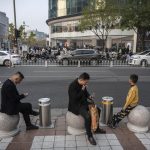It comes as Victoria has recorded 61 new locally acquired cases of Covid-19 on Saturday.Of the local cases, just 22 were in isolation for the duration of their infectious period and 48 are linked to known outbreaks.Premier Daniel Andrews announced a further 16 local cases which were recorded on a rapid PCR testing platform, which will be included in tomorrow’s numbers.Mr Andrews said given there were signs the virus was spreading beyond Greater Melbourne, regional Victoria would be plunged into lockdown from 1pm on Saturday.Regional Victorians will be subject to the same restrictions as those in Greater Melbourne, but they will not have a 9pm-5am curfew.Stronger restrictions will also be brought in in a bid to protect children, as the number of infections amongst kids continues to rise.Childcares will only be open for the kids of essential workers with a valid permit.Some industry-specific changes will also be made.“A number of high-risk industries will not be able to operate at 100 per cent,” Mr Andrews said.“They will have to reduce just as the construction sector has done, construction will be reduced to 25 per cent across the whole state.”He said abattoirs, meat processing centres, large supermarket distribution centres, and cool stores were among those that would be affected.Daniel Andrews said the number of cases who had been infectious out in the community over the last few days and the number of mystery cases emerging in different areas across the state was “extremely concerning”.“We need to slow the spread of the virus and get in front of this outbreak,” Mr Andrews said.NED-4292-Percentage-of-eligible-population-fully-vaccinated-by-stateNED-3869-Covid-19-Exposure-Sites-VictoriaNSW HAS 642 CASES; NEW CURFEW, MASK, LOCKDOWN RULESGreater Sydney residents will be in lockdown until the at least the end of September as NSW recorded 644 new locally acquired Covid-19 cases on Friday.NSW Premier Gladys Berejiklian confirmed the extension this morning, as she announced “areas of concern” — local government areas in southwestern and western Sydney — would be subject to curfew, starting on Monday, that will run from 9pm to 5am.It means people will not be able to leave there homes between these hours unless it is for authorised work or emergencies.Residents of these areas will also be limited to one hour of exercise each day, and more retailers will have to close except for click and collect orders.A mask mandate has also been introduced for all NSW residents. The facial covering must be worn at all times when outside the home, except when undertaking strenuous exercise.“Our concern is that when people are walking past a group of people or accidentally bumping into people that, that can cause that fleeting contact can cause transmission, and even when you’re exercising, you need to have the mask unless you’re doing some strenuous exercise,” Ms Berejiklian said.She described the new restrictions as a “final list” to drive infections down, and said they were introduced due to the “sudden escalation in cases” and feedback from police “about a handful of people flagrantly disregarding the rules.”NSW Covid Exposure Sites“For that reason, I asked health and police to work together, to give me a final list of what we can throw at this, to leave no shadow of a doubt as to how serious we are about getting the rate of growth down, the case numbers down. I do not want to leave a shadow of a doubt,” she said.At least 40 of Friday’s new cases were infectious while in the community, and four people tragically lost their lives to the virus.Chief health officer Dr Kerry Chant said there were 470 Covid-19 cases currently in hospital, and 80 people were in intensive care.“The vast majority of those are not vaccinated. The others have only received one dose of vaccine,” Dr Chant said.She also confirmed vaccine booster doses would arrive in 2022 as the Covid battle becomes a long-haul fight.“Pending advice, there will be other vaccines and booster doses available next year, so in terms of longevity of protection, be assured of the booster doses will be available,” she said.NED-4090-Greater-Sydney-Restrictions-mapQLD SAYS IT’S NOT IN AN OUTBREAKQueensland’s top doctor has eased the urgency on distributing the AstraZeneca jab because the state is “not in an outbreak”.Supply of the vaccine was ramped up to issuing the second dose eight weeks after the first when the Delta cluster plagued the state’s southeast earlier this month.But on Friday, chief health officer Jeannette Young said this urgency would be eased to 12 weeks between the two jabs.“So for the vast majority of people, given we are not in an outbreak in Queensland at this point in time, wait for 12 weeks to get a second dose of AstraZeneca,” she told reporters.Dr Young also reiterated the new eligibility rules for the Pfizer jab announced by the Prime Minister on Thursday.Australians aged 16 to 39 will be able to access Pfizer vaccines from August 30 after a boost to supply of the vaccine was confirmed earlier in the week.“Here in Queensland, I ask you all to register,” Dr Young said to the younger residents in the state.“Then we can manage those bookings because I do not want an empty slot in any of our vaccine clinics. I want to pull people in so we can fill every single slot. “The easiest way to do that is for people to register and then we can say come ahead and book and make sure that all of those spots are taken up.”The top doctor said authorities will then turn their focus to vaccinating those aged between 12-15, with those who have underlying medical conditions to be preferred.“For 12-15-year-olds, if you have any serious underlying disease, work with your paediatrician and make sure you organise a vaccine,” Dr Young said.“It will not be long and will be looking at vaccinating all 12-15 -year-olds but at the moment it is only First Nations kids, 12-15 and kids with severe underlying disease.”Dr Young has faced widespread criticism for her stance on vaccinations with eligibility criteria changing regularly based on various Covid-19 threats in the state.The CHO made national headlines during the state’s earlier lockdown in June when she declared AstraZeneca should not be taken by under 60s despite a change in the ATAGI recommendation.NED-4235-Australias-Vaccine-Rollout-TimelineAustralian Medical Association vice-president Chris Moy slammed this opinion at the time as “inappropriate” and reiterated his frustration with the CHO’s views earlier this month.“My concern is advice that is given in a way that looks like a command can significantly reduce confidence in a vaccine that has been very effective,” he told NCA NewsWire.“On the one hand she has concerns about a very tiny risk of doing something – which is giving the vaccine – but there’s also a massive risk in not doing something.“If there’s an outbreak and people aren’t vaccinated, you’ve seen what is happening in Sydney at the moment and the number of people who are in hospital.”NED-3869-Covid-19-Exposure-Sites-QldEIGHT NEW ASTRAZENECA BLOOD CLOTS, NO DEATHSAustralia has recorded eight more cases of rare blood clots linked to the AstraZeneca vaccine.In its weekly safety report, the Therapeutic Goods Administration said there was one ‘confirmed’ case and seven ‘probable’ cases.The confirmed case was a male, 59, from Western Australia.The probable cases were in two men from NSW, aged 56 and 76; two women from NSW aged 52 and 91; a Queensland woman aged 28; a 60-year-old Victorian man; and a 64-year-old man from Western Australia.This takes the total Australian reports assessed as rare blood clots or Thrombosis with thrombocytopenia syndrome (TTS) following the AstraZeneca vaccine to 112 cases (62 confirmed, 50 probable) from about 8.1 million vaccine doses. NED-3619-AstraZeneca blood clots-What we knowTo date, there are no TTS cases in Australia that have definitively been linked to a second dose of the AstraZeneca vaccine. No deaths have been reported in the last week. Six deaths have been reported over the preceding 4 months – 5 of the 6 deaths occurred in women aged 34, 48 (2 cases), 52 and 72-years-old. The other death was in a 44-year-old man. In Australia, severe cases of TTS appear to be more common in women in younger age groups. Nearly half of the TTS cases in women required treatment in intensive care.The TGA advises people should seek immediate medical attention if they develop any of the following symptoms after vaccination:severe or persistent headache, blurred vision, confusion or seizuresshortness of breath, chest pain, leg swelling or persistent abdominal painunusual skin bruising and/or pinpoint round spots beyond the site of vaccination.The most common time period for onset of TTS symptoms is 4–30 days after vaccination.
Powered by WPeMatico






